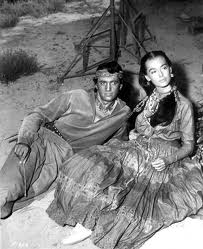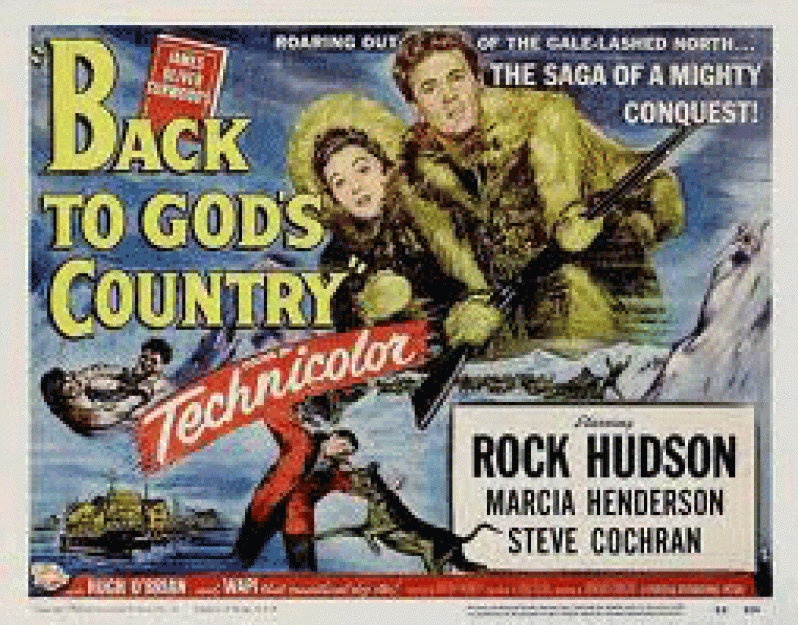What is distinctly pleasurable about Rock Hudson’s 1950s films is their overall emphasis on the importance of maintaining social placidity, and the role of the individual example in achieving this.  There is the vital and attractive quality of a ‘Pop Culture’ sensibility in these 50s Hudson films which equates movies with products as essential to our well-being and human contentment as food, the appreciation of nature, and the pursuit of work that contributes both to the happiness of others and ourselves. This is apparent in a beautiful Hudson color film of 1953, rarely seen today: ‘BACK TO GOD’S COUNTRY’, based in the Canadian outdoor wild environment, where Hudson is an ex-Sea Captain who returns to settle down in simple domestic contentment, and is frustrated and threatened by the obstacles placed in his way by an envious villain played by Steve Cochran. Too often a jaded, cynical and critical outlook on such films reduces their positive sentiments to nothing but an implausible value. But the social accuracy and foresight of conflicts and their resolution in other Hudson films like: ‘BEND OF THE RIVER’,(1952); ‘GUN FURY’ (1953); ‘TAZA, SON OF COCHISE’ (1954)’ ‘ALL THAT HEAVAN ALLOWS’, ‘BATTLE HYMN’ and GIANT’ (1956); ‘WRITTEN ON THE WIND’ (1957); ‘SOMETHING OF VALUE’ (1957); and ‘THIS EARTH IS MINE’ (1959), will not become irrelevant to human and social survival any time soon.
There is the vital and attractive quality of a ‘Pop Culture’ sensibility in these 50s Hudson films which equates movies with products as essential to our well-being and human contentment as food, the appreciation of nature, and the pursuit of work that contributes both to the happiness of others and ourselves. This is apparent in a beautiful Hudson color film of 1953, rarely seen today: ‘BACK TO GOD’S COUNTRY’, based in the Canadian outdoor wild environment, where Hudson is an ex-Sea Captain who returns to settle down in simple domestic contentment, and is frustrated and threatened by the obstacles placed in his way by an envious villain played by Steve Cochran. Too often a jaded, cynical and critical outlook on such films reduces their positive sentiments to nothing but an implausible value. But the social accuracy and foresight of conflicts and their resolution in other Hudson films like: ‘BEND OF THE RIVER’,(1952); ‘GUN FURY’ (1953); ‘TAZA, SON OF COCHISE’ (1954)’ ‘ALL THAT HEAVAN ALLOWS’, ‘BATTLE HYMN’ and GIANT’ (1956); ‘WRITTEN ON THE WIND’ (1957); ‘SOMETHING OF VALUE’ (1957); and ‘THIS EARTH IS MINE’ (1959), will not become irrelevant to human and social survival any time soon.
Douglas Sirk and Hudson
The second influential film director who recognised and developed Hudson’s aptitude for demonstrating some of the best values of man, is Douglas Sirk, whose films with their bold unapologetic and sensitive topics related to family conflicts, freedom from class and age barriers, and revelations of personal embarrassments and failures, exist like therapeutic practical dramas in celluloid. ‘TAZA, SON OF COCHISE’, directed by Sirk, is one of Hudson’s best films, deeply prophetic about the differences and conflicts spawned by the historical and on-going collision of cultures, and the necessary adjustments both sides must make in the establishment of social cohesion and acceptance of new forms of knowledge helpful to each. With ‘TAZA, SON OF COCHISE’, Hudson projected an ability to embody the catalytic role, which signifies a sensitive masculine heroism and wisdom different from the inflexibility of his native Indian peers, and the US Cavalry’s stubborn defense of Western expansion in the Native Indian American wilderness.
‘Taza’s’ special artistic values
The beauty and importance of ‘TAZA, SON OF COCHISE’ exists in its combination of stunning Apache Indian designs, clothing, artifacts, social customs , and cosmic integration with the geographic terrain. The film opens unforgettably with Jeff Chandler (whose name is significantly absent from the credits), brilliantly replaying his earlier role as Cochise in ‘BROKEN ARROW’; this time as the dying Cochise instructing his two sons, Taza and his brother, about his wish for their people to continue their lifestyle in peace with the white settlers, sets the tone for the film’s exploration of ethnic values in transition, but not erased, and Western civilization’s necessary shift beyond racial egotism and superior dominance.
In this new situation, Hudson as Taza, must rely on his individual powers of reason and influential forgiveness to guide his tribe successfully away from short-sighted and self-destructive pride in instinctive bravery and violence, promoted by rivals within his tribe. Sirk’s ability to inject serious and memorable examples of Westernization’s corrupting materialistic influence on vulnerable people mesmerized by new commodities and money, is achieved expertly by the film’s physical action, its camera’s love of sharp color, native structures, imagery, and Hudson’s and Barbara Rush’s passionate love, in perhaps Hudson’s greatest purely heterosexual role.



.jpg)








